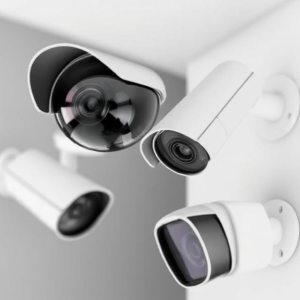A Wireless Home Security System is a system designed to protect your home from intruders, burglars, or other dangers. Unlike traditional security systems that require a lot of wiring, wireless systems use radio signals or Wi-Fi to connect all the different parts of the system, making them easier to install and more flexible.

How Does It Work?
A wireless home security system works by connecting different security devices like cameras, sensors, alarms, and control panels to each other through wireless technology (like Wi-Fi or Bluetooth). These devices send signals to a central hub or your phone, allowing you to monitor your home remotely.
Here’s how the basic parts work together:
- Security Cameras: These are placed around your home, both inside and outside, to watch for any unusual activity. They capture video footage, which is sent wirelessly to your phone or the security company.
- Motion Sensors: These sensors detect movement in specific areas, like in hallways or near doors. If they sense motion, they send an alert to you or trigger an alarm.
- Door and Window Sensors: These sensors attach to doors and windows. When the door or window is opened, the sensor detects it and sends a signal to the system, alerting you of a possible entry.
- Control Panel: This is like the “brain” of your system. It connects to all the devices (cameras, sensors, etc.) and allows you to control everything, often from a mobile app on your phone.
- Alarm or Siren: If the system detects a break-in or emergency, an alarm goes off to scare off intruders or alert you and others nearby.
- Mobile App: Many modern systems come with a mobile app that lets you monitor your home remotely. You can view live footage from cameras, get alerts about motion or broken sensors, and even control the system from anywhere.
Key Features of a Wireless Home Security System:
- No Wires: As the name suggests, wireless systems don’t use wires to connect the devices, making installation much easier and more flexible.
- Remote Access: You can control and monitor your system from your smartphone, tablet, or computer, no matter where you are, as long as you have an internet connection.
- Easy Installation: Because there’s no need to drill holes or run wires, installing a wireless security system is usually quick and easy. Many systems are DIY (Do It Yourself) and can be set up in just a few hours.
- Real-Time Alerts: If something suspicious happens (like someone opening a door or window), the system will immediately send an alert to your phone or other devices.
- Customizable: You can add more sensors, cameras, or alarms to the system depending on your needs. For example, you might add a camera in the backyard or a motion sensor in the garage.
Types of Wireless Security Devices:
- Cameras: These can be placed indoors or outdoors and come in different types:
- Indoor cameras: For monitoring the inside of your home.
- Outdoor cameras: Weatherproof cameras to keep an eye on the exterior of your home.
- Doorbell cameras: These are attached to your front door and let you see and communicate with visitors via your phone.
- Sensors: These are small devices that detect motion, door/window opening, or even glass breaking. When triggered, they send alerts to your phone or the system’s control panel.
- Smart Locks: These allow you to lock and unlock doors from anywhere, using your phone. Some smart locks can also automatically lock when you leave the house.
- Environmental Sensors: These detect things like smoke, carbon monoxide, or water leaks in your home. They help protect against fires, gas leaks, or flooding.
- Smart Lights: Some systems also include smart lights that can be controlled remotely. You can set lights to turn on and off at certain times to make it look like someone’s home.
Advantages of a Wireless Home Security System:
- Convenience: You can monitor your home from anywhere using your phone, and control everything with a tap.
- Flexibility: Wireless systems are easy to expand. You can add more cameras or sensors whenever you want.
- No Need for Expensive Installation: Traditional systems can require professional installation, which can be costly. With wireless systems, you often don’t need a professional to set things up.
- Portability: If you move to a new house, you can take the system with you and set it up in your new home.
- Custom Alerts: You can customize the alerts to notify you of specific things, like when a door is opened or when motion is detected in certain areas.
Disadvantages of a Wireless Home Security System:
- Internet Reliance: If your internet goes down, the system might stop working. Some systems have backup options, like cellular connections, to avoid this problem.
- Battery Life: Some wireless devices run on batteries, so you have to replace or recharge them regularly. If the batteries run out, the system won’t work.
- Potential Security Risks: Like any technology connected to the internet, wireless systems could be vulnerable to hacking. It’s important to use strong passwords and follow other security measures to protect your system.
Real-World Examples:
- Ring: A popular brand known for its video doorbells that let you see and talk to people at your door through your phone. They also offer cameras and alarm systems.
- SimpliSafe: This system offers wireless cameras, sensors, and smart locks, with a focus on DIY installation and no long-term contracts.
- Nest Secure: Google’s home security system that includes cameras, sensors, and a smart home integration with other Google products.
How to Set Up a Wireless Security System:
- Choose Your Devices: Decide what kind of devices you want (cameras, sensors, doorbell camera, etc.).
- Download the App: Install the system’s mobile app to set up and control the system.
- Place the Devices: Position your cameras, sensors, and other devices where you need them, following the instructions.
- Connect to Wi-Fi: Make sure all devices are connected to your home’s Wi-Fi network.
- Test and Customize: Test the system to make sure everything works, and set up alerts and other preferences in the app.
In Summary:
- A Wireless Home Security System uses Wi-Fi or radio signals to connect various security devices (like cameras, sensors, and alarms) without the need for wires.
- It allows you to monitor your home remotely from your phone and provides real-time alerts if something suspicious happens.
- Advantages include easy installation, flexibility, and convenience, while disadvantages include reliance on the internet and battery life.











